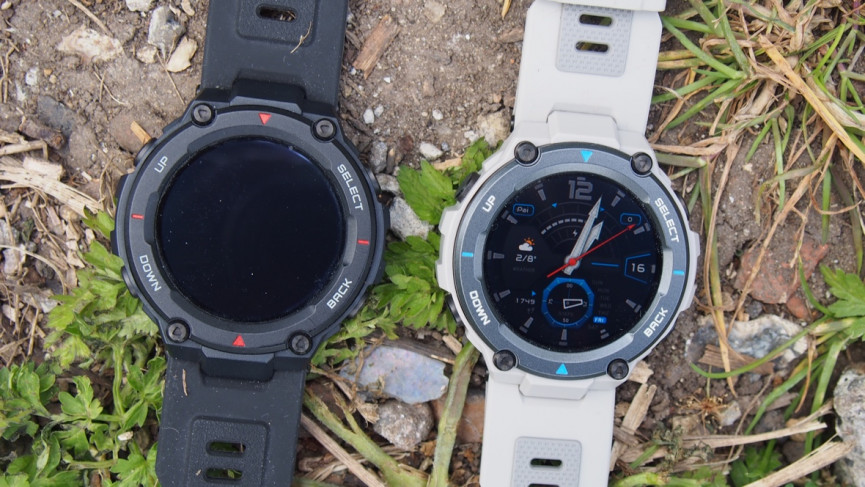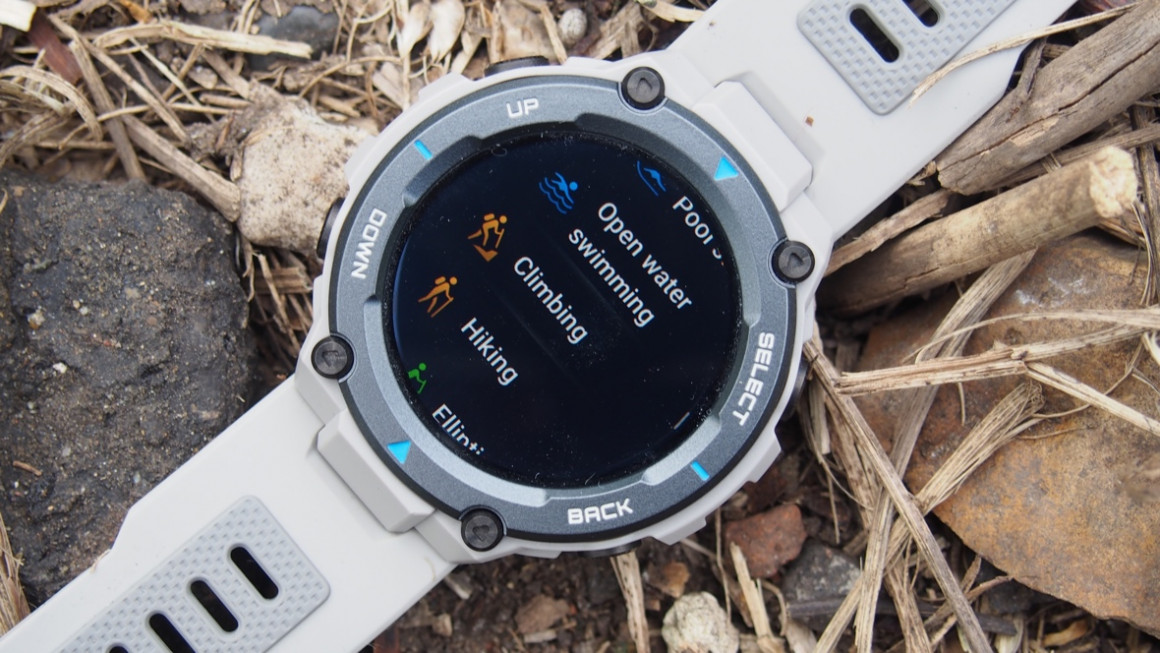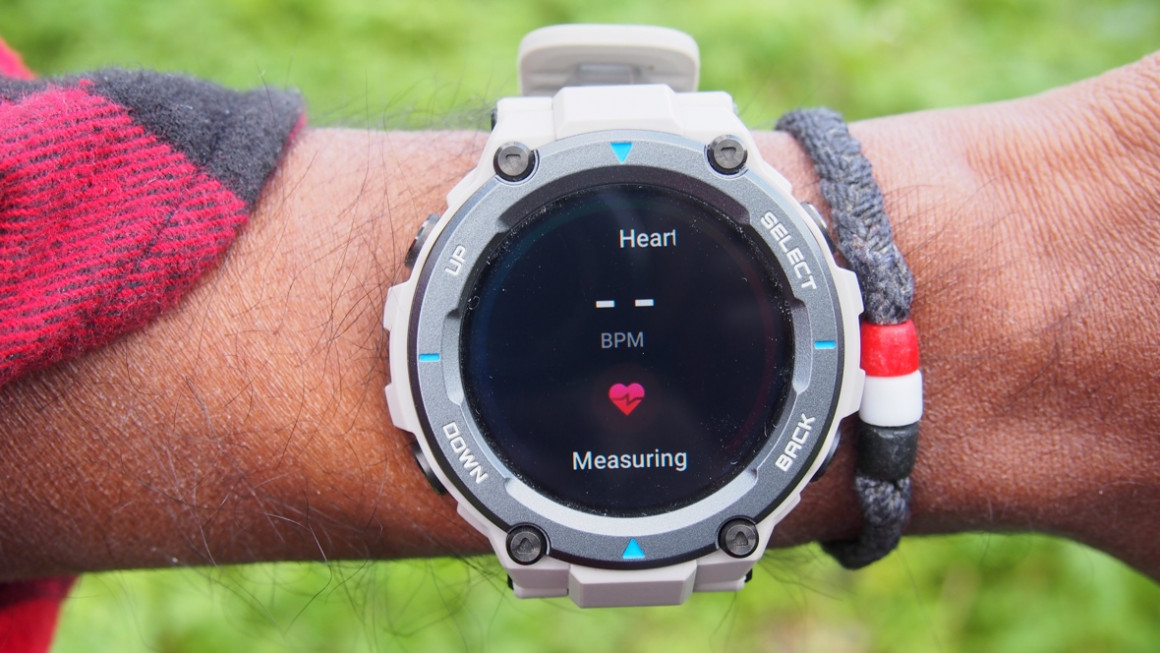
- Plenty of sports tracking modes
- Largely reliable tracking
- Affordable price
- Still feels a bit too light and cheap
- Still no navigation features
- Not hugely different from T-Rex
The Amazfit T-Rex Pro is the successor to the T-Rex, a watch that has zero to do with dinosaurs and everything to do with being an Garmin alternative outdoor watch that's built for serious exploring.
So what's new? Well, Zepp Health (formerly known as Huami) has beefed things up in the durability department, slapping it with more military grade certificates, brought in a new sensor, greater mapping support and still managed to keep it affordable.
At , the Pro comes in more than the original T-Rex. If you're in the hunt for an outdoor watch, but something like the Garmin Fenix 6, Garmin Instinct Solar or Coros Vertix is financially out of reach, then the T-Rex Pro will turn heads.
We've been spending some time outdoor in the sun and the even the snow to see if the T-Rex Pro offers much more than first T-Rex and is an outdoor watch to get on your wrist.
Amazfit T-Rex Pro: Design and screen

Looks-wise, the T-Rex Pro doesn't hugely differ from the first T-Rex, though it does ramp up the military certifications to make it a tougher watch to live with.
It's up from from 12 certifications to 15, making it something that's heat, cold and humidity resistance at extreme levels. It's also got military standard levels of resistance against ice and freezing raining too. We can't say that we've been able to tackle extreme heat or freezing rain, but it's a watch that's shown no signs of issues in the conditions we have tested it in.
Like the T-Rex, you're getting a 47mm polymer case that measures in at 13.5mm thick. It's up slightly in the weight department going from 58g to 59.4g, so not the kind of difference you really notice.
It's a light watch to wear and while we're not against a light watch, there's something about that case that just feels a bit cheap and plasticky to us and feels like maybe a little bit of extra weight might not be such a bad thing.

Amazfit T-Rex (left) vs T-Rex Pro (right)
The case is partnered up with 22mm silicone strap, which does have a nice stretchy feel to it and hasn't been uncomfortable to wear or caused any issues in our time with it.
To take control of the Pro, you've got four physical buttons that operate in the same fashion as they did on the T-Rex and there is a touchscreen display. It's the same 1.3-inch, 360 x 360 resolution that offers, bright sharp, responsive place to swipe and tap your fingers on it. If you want that screen to always be on, you have that option here too.

Zepp has swapped Corning's Gorilla Glass 3 for tempered glass, which offers something that's now both shatter and a scratch-proof – upping things in the durability department.
It's now better equipped for water adventures with a 10ATM water resistance rating that makes it fit for swimming up to 100 metres depth.
So what you're really getting here over the T-Rex is something that's built to be tougher with everything else pretty much staying the same. It looks like an outdoor watch, is comfortable to wear and if you like that bulky exterior look, then the Pro will appeal.
Amazfit T-Rex Pro: Sports tracking

In true Amazfit fashion, you get plenty of sports and fitness tracking features for your money here.
There's Zepp Health's BioTracker 2 optical sensor (found on its newer smartwatches) that brings heart rate monitoring and SpO2 measurements, and enables altitude alerts when you hit that higher, more challenging terrain. There's a barometric altimeter to measure elevation, which isn't available on the standard T-Rex.
It widens the support for satellite systems covering GPS+Glonass, GPS+BeiDou and GPS+Galileo. The T-Rex in comparison only offers GPS+Glonass support. What that means it that when you track a workout, you should have a mapped route at the end of it.
What you don't get here is any sort of navigation features. So no maps to follow in real-time on your watch, no ability to upload routes or back to start modes. These are features you can find on watches like the Garmin Fenix and Instinct, Polar's Grit X and Vantage V2 and you even get basic navigation features on the Honor Watch GS Pro.
Your get over 100 activity modes including modes for trail running, climbing, hiking, open water swimming with additional metrics on offer like altitude and speed where appropriate. There's something Zepp calls ExerSense, which is essentially its take on automatic exercise recognition. It supports eight different exercises and that includes rowing, running, walking and swimming.
If you take your training and recovery seriously, there are series of insights on board powered by analytics firm Firstbeat who offer similar features for Garmin and Huawei watches. This gives you an insight into training load, recommended recovery time, VO2 Max and training effect insights based on FirstBeat's heart rate based algorithms.
In terms of third party app support, Android users can also fire over data to Google Fit and it also works with Strava sending over data from activities like running, cycling and swimming to the popular app.
Running

Run tracking compared: Amazfit T-Rex Pro (left and centre) and Garmin Enduro (right)
For outdoor running and trail running, the Pro generally performs well for distance tracking, with accuracy usually either a little shorter or slightly longer than what we captured on a Garmin Enduro.
It generally had us running a slightly quicker average pace, but it wasn't kind of the inaccuracy to be hugely alarmed about. It generated similar profiles for elevation graphs with the Pro being more generous with elevation gain and loss numbers. Running dynamics like cadence, were noticeably lower.

Elevation data compared: Amazfit T-Rex Pro (left) and Garmin Enduro (right)
With those aerobic training effect and anaerobic training effects, the aerobic one largely matched the scores generated by the Garmin paired to a chest strap monitor, though was two points higher for anaerobic scores. This is all influenced by heart rate monitor accuracy, which we'll get into later.
Despite the increased satellite system support, the app failed to show our mapped route, so there's clearly some software bugs that need to be addressed here.
There always seems to be software issues with Amazfit watches in the Zepp app around the review period, and usually these get resolved quickly. Here's hoping those issues get ironed out too.
Swimming

Swim tracking compared: Amazfit T-Rex Pro (left and centre) and Form Swim Goggles (right)
We didn't brave the open waters but we did manage to make it into the pool with the T-Rex Pro and it largely performed well when put up against the very reliable swim tracking on the Form Swim Goggles.
Once you've selected pool length you have the ability to display a real-time graph for stroke rate, turn on auto lap tracking and keep the screen on throughout the session. You can also set alerts based on lap, time but even to remind you when you drink water or refuel, which is a nice touch.
Once you get swimming, the display you can see real-time stats like workout time, distance, laps, average pace, average SWOLF, average stroke rate. While we'd have preferred data fields to be a bit larger, screen visibility in the water was good.
On the accuracy front, it was a few lengths short of the Form goggles and average pace tracked a little slower, though it did deliver similar calorie burn numbers. It's a solid swimming tracking experience on the whole, even if accuracy was a little off.

Exercising indoors isn't hugely different from what we've seen from other Amazfit watches. Activities like jumping rope and indoor rowing offering some additional metrics outside of workout duration and heart rate data.
For indoor rowing sessions both manual and automatically tracked, metrics like stroke rate were similar to what was generated by the row tracking on the Garmin Enduro.
For that automatic exercise tracking, you'll need to select the exercises you want to automatically track in the watch settings. We'd say though that sticking to manual tracking is the way to go to make sure you get the richest data.
Amazfit T-Rex Pro: Fitness tracking

Amazfit watches are pretty consistent as far as what they offer as 24/7 activity trackers and automatic sleep monitors on and off the watch.
For daily tracking, you can check the Activity Goal to see your daily step count, distance covered and time spent on your feet each hour. On the app, you can delve into weekly and monthly steps to see if you stayed consistent and see when those steps occurred over a day.

Step tracking compared: Amazfit T-Rex Pro (left) and Garmin Enduro fitness tracking (right)
Accuracy-wise, we found sometimes it was 500 steps off a Garmin and Fitbit fitness tracker but also posted some wildly larger step counts as illustrated in the screens above. Hourly Inactivity alerts aside, there's little in the way of motivational features here to make sure you keep moving or to make the most of that time you do remember to move a few hundred steps to make those inactivity alerts go away.
You do also have the PAI assessment scores, which seeks to reward you with points based on how regularly you raise your heart rate. As we've said previously with its presence on other Amazfit watches, it's a potentially great concept to move people away from obsessing over steps. Our concerns with the heart rate monitor accuracy and the failure to really make it feel part of the overall tracking process lets it down from being really useful right now.

Sleep tracking compared: Amazfit T-Rex Pro (left) and Fitbit Sense (centre and right)
When it's time to sleep, you'll be able to capture sleep duration, sleep stages including REM sleep and receive a sleep score to let you know at a glance how good or bad you've slept. It'll also track naps, offer some basic insights and compare your data to fellow Amazfit users.
Accuracy-wise, we put it up against the sleep tracking on Fitbit's Sense smartwatch and found that it actually performed quite well. It recognised similar sleep periods give or take a few minutes and offered similar sleep scores. In terms of the sleep stage breakdown, it delivered similar length deep, light and REM sleep times and on the whole is one of the strongest aspects of the T-Rex Pro and the Amazfit ecosystem as a whole.
Amazfit T-Rex Pro: Heart rate and SpO2 accuracy

Zepp Health has included its new optical sensor tech here that delivers heart rate monitoring and blood oxygen measurements. As a heart rate monitor, it's similar experience to what we've found with that BioTracker 2 sensor on other Amazfit watches. It's a better fit for resting heart rate data than it is for exercise.
On the watch, you can take on the spot measurements and those were at most 1bpm off from the heart rate monitor on a clinically tested pulse oximeter.
On the app, you can view resting heart rate, see the heart rate zones you've spent time over the day along with daily max, minimum and average heart rate readings. Those continuous and daily readings were usually within 4-5bpm of a Garmin optical heart rate monitor that we've found pretty reliable for this type continuous monitoring.

HR tracking compared: Amazfit T-Rex Pro (left) and Garmin HRM-Pro chest strap monitor (right)
For exercise, we didn't get great results overall. Whether it was steady paced workouts or upping the intensity, maximum and average readings were quite far off what we recorded from Garmin's HRM Pro chest strap monitor.
As mentioned, this heart rate data feeds into features like PAI scores and the Firstbeat-powered training and recovery insights, which raises questions how useful those insights are based on the performance of the heart rate monitor for workouts. It's also used for stress tracking, with on the spot measurements far more reliable than the continuous monitoring too.
The SpO2 sensor here is new to the T-Rex range and offers on the spot measurements but won't continually monitor SpO2. It will also prompt you to do the test when you hit ascents over 400 metres and will do something similar when you hit 4,000m+ ascent.
It's not for medical use and tagged as something to use as a reference for your current blood oxygen levels. We did find that readings were at least in line with an iHealth pulse oximeter we tested it against though.
Amazfit T-Rex Pro: Smartwatch features

As a smartwatch, the T-Rex Pro offers everything you get on the T-Rex and from our time with it and nothing really new from what we could see.
Like the entirety of the latest Amazfit range, it's one that works with Android phones and iPhones. That gives you features like notifications, music controls, weather forecasts, alarms and the ability to set up reminders.
We have seen features like smart assistants and built-in music players appear on other Amazfit watches, but the T-Rex Pro is keeping it to the basics here.
As a place to view notifications, you can swipe right from the main watch face screen to see your feed. For notifications like emails, you'll only be able to see the subject line while a flurry of messages from apps like WhatsApp pile up and you'll need to reach for your phone to read them in detail. Unlike smartwatches like the Samsung Galaxy Watch, it doesn't pull through images either.

Music controls in general work well on Amazfit watches and that doesn't really change here. You can't access music controls however during workout tracking, which is slightly disappointing. That kind of support seems to vary across the Amazfit range.
Viewing the weather is always a nice experience with a nice visual breakdown of future weather nicely presented. Features like setting reminders, the stopwatch and settings timers all work without issue here too.
You do have watch faces of course, and they're the data-rich kind to match this watch and its designs to be for exploring. You have a handful already pre-installed and then you head to the Zepp app to find more in the Store. There's a nice range of digital and analogue-style options to choose from here, so you should be able to find something you like here.
So as a smartwatch the T-Rex Pro isn't bringing anything we haven't already seen on Amazfit watches. You can get far richer smartwatch experiences else where, but what does make it on the Pro works without much issue.
Amazfit T-Rex Pro: Battery life
The T-Rex Pro packs in the same capacity 390mAh battery as the first T-Rex and there's some battery gains and losses depending on how you use it.
It drops to 18 days from 20 days in typical usage, with heavy usage at 9 days and GPS battery life up 20 hours to 40 hours when you need to track your outdoor pursuits.
We'd say our time veered on the heavy usage with all features turned on and regular exercise tracking and it was closer to 10 days with a daily drop-off of around 10-15%. It's a good showing, maybe not as great as Zepp Health claims it can go though in heavy usage.
In terms of those GPS battery numbers, we found that an hour of running knocked the battery around 6-7% on average, which would roughly work out to less than 20 hours of GPS battery life based on those numbers. So not quite the huge 40 hours promised.
When it comes to charging, you've got the same slim charging cable that magnetically clips onto the back of the case and will get you from 0-100% in an 1.5 of charging.
How we test
